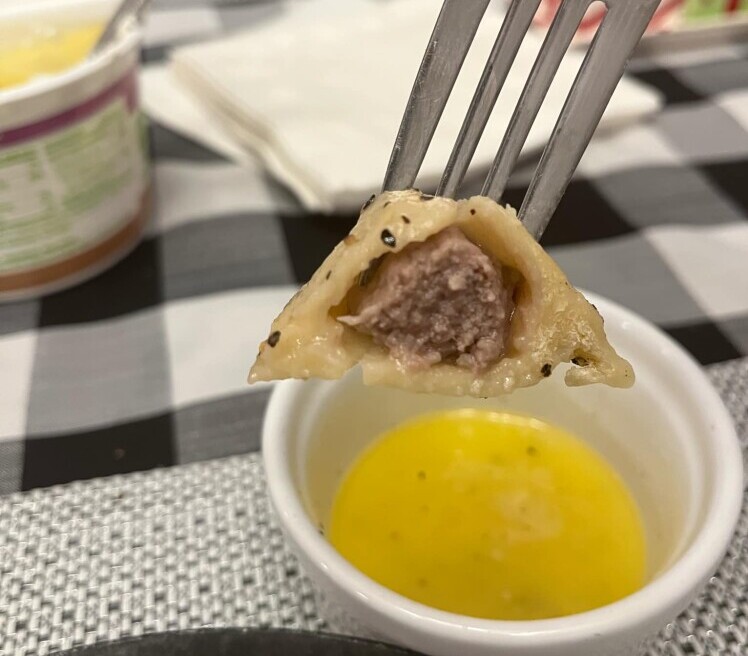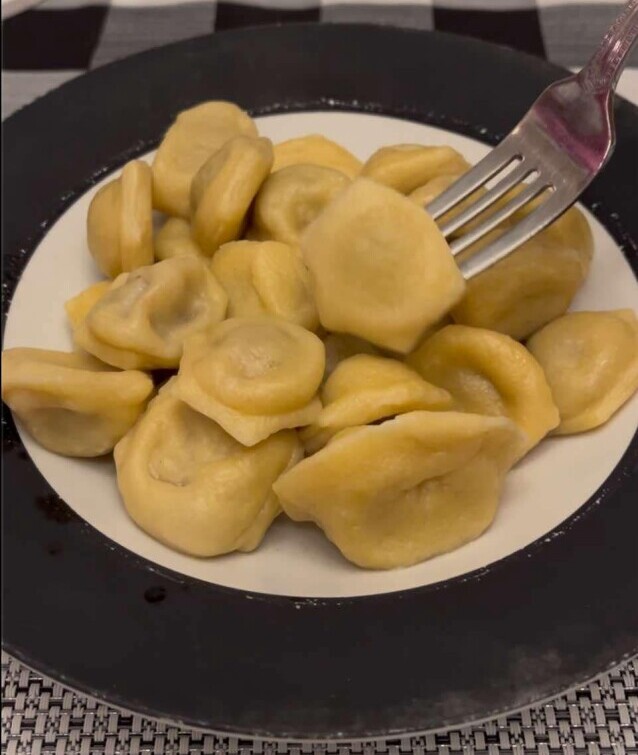The Tastiest Pelmeni
Jump to Recipe


Pelmeni, a culinary gem in Russian cuisine, carries a rich history that stretches back through the ages. This delightful dish, beloved for its hearty simplicity, represents more than just a meal—it’s a historical tapestry woven with cultural exchange and culinary innovation.
The origins of pelmeni have intrigued food historians for years, sparking debates and leading to several theories. One popular belief points to the steppes of Siberia, suggesting that the dish was influenced by Chinese dumplings during times when travelers and traders journeyed along the Silk Road. This notion highlights the interconnectedness of food cultures, where ideas and recipes blend and transform across regions.
Immigration and trading routes played a significant role in pelmeni’s journey across Eastern Europe. Over centuries, as people moved and settled in new lands, they brought with them the comforting flavors of pelmeni, adapting the dish to local ingredients and tastes. This dissemination is a testament to how communities preserve their identity while embracing new culinary horizons.
Historical records offer fascinating insights into the preparation of pelmeni. In many tales, pelmeni was not merely sustenance; it was a communal activity. Families would gather, crafting these delicate meat-filled dumplings during cold winter months. This ritual not only ensured food supplies were preserved through harsh weather but also bonded communities through shared tradition.
Pelmeni stands as a symbol of culinary resilience and creativity, showcasing the enduring love of Eastern European societies for simple yet flavorful fare. Today, it has merged its way onto the tables of modern homes worldwide, where it continues to be celebrated for its rich taste and fascinating past. By recognizing its history, we pay homage to the myriad influences that have shaped this delicious dish into what we cherish today.
Discovering the Delightful World of Pelmeni Fillings
Traditional pelmeni fillings are the heart of this beloved dish, offering an explosion of flavors with every bite. Typically, you’ll find them filled with minced pork, beef, or lamb. Each type of meat brings a unique taste, from the hearty richness of beef to the savory depth of lamb, offering a comforting and satisfying meal.
As you explore pelmeni, you’ll notice that fillings have evolved over the years. Cooks and chefs continuously experiment, incorporating ingredients available in their region. For instance, in some areas, you’ll find pelmeni filled with potatoes or mushrooms, catering to those who prefer meat-free options. This adaptability showcases how pelmeni can be tailored to suit a variety of dietary preferences.
In recent years, dietary trends have further expanded the range of pelmeni fillings. With more people choosing vegetarian or vegan lifestyles, it’s common to see plant-based trends reflected in modern interpretations of pelmeni. Innovative fillings like mashed potatoes, lentils, tofu, or textured vegetable proteins are becoming increasingly popular, allowing more people to enjoy this traditional dish without compromising on flavor.
Regional variations also play a significant role in the diversity of pelmeni. Across Russia and neighboring countries, each area boasts its own twist on fillings, showcasing local flavors and culinary customs. From using freshly caught fish in coastal regions to incorporating spices unique to particular areas, these variations provide a delightful insight into local culinary practices.
Making pelmeni at home offers a rewarding way to experiment with flavors. Start with the classic meat variety, then gradually experiment with different ingredients to find what suits your palate best. Consider trying seasonal vegetables, herbs, or even a mix of cheeses to create your signature filling. This personal touch not only enhances the flavor but also makes the dining experience more personal and enjoyable.
My First Experience with Pelmeni
I took long multiple flights from Phoenix, AZ USA, to Russia. After leaving 80 degree F weather in March and arriving in Yekaterinburg, Russia where is was 12 degrees F. My then girlfriend (now wife) met me at the airport and the first thing we did was go to the apartment and eat. She boiled some beef/pork pelmeni and we began eating. I couldn’t think of a better dish after an exhausting amount of flying and dealing with the cold March weather in Russia. It was rich, tasty, hearty, and very satisfying.
It can be dipped in melted butter, sour cream, ketchup, or whatever you like. Below is the recipe, it’s a lot of work and is best done with multiple people helping.
Ingredients
Meat Filling
- 2 lbs ground beef
- 1 medium onion finely chopped
- 1/2 to 3/4 cup milk
- 1/2 teaspoon black pepper
- 1 tablespoon salt
- 1 1/2 teaspoons garlic powder
- 1 tablespoon oil (sunflower oil would work, for healthier choose avocado oil or olive oil)
Dough
- 6 cups flour
- 1 teaspoon salt
- 2 eggs
- 1 tablespoon oil
- 2 cups water
Instructions
- In a bowl, combine the ground beef, chopped onion, milk, salt, pepper, garlic powder, and oil until all ingredients are evenly spread throughout meat
- In second bowl, add the flour and salt, mix together
- In a third bowl, add the eggs and water. Beat eggs and water until combined
- Add egg/water mixture to the flour/salt mixture and combine with a spoon
- Once combined, it should form a dough
- Knead the dough thoroughly using all your strength, Do this for 15 to 20 minutes
- Roll out dough and use a rolling pin to make dough almost paper thin
Method with a pelmeni maker:
- Place dough over pelmeni maker
- Roll dough over pelmeni maker using rolling pin
- Push dough with thumbs into holes in pelmeni maker being careful not to break the dough
- Place ground meat mixture into dough holes.
- Roll out another sheet of dough and place on top of dough with meat in the holes
- Use rolling pin over dough again
- Carefully pop out pelmeni from maker and place on a large dish or cutting board
- Repeat steps above until all dough is used up
Method without pelmeni maker, by hand:
- Cut out the dough using the top of a jar that’s two inches in diameter
- Place a little bit of meat in the middle of dough and fold dough over forming a half circle
- Press dough together to seal meat inside
- Take one corner of the pelmeni and fold it over to the other corner and press together.
- Place pelmeni on a large dish or cutting board
- Repeat steps above until all dough is used up
Continuing:
- Place pelmeni in the freezer for another day, or boil if you want to eat right away
- Boil pelmeni until it floats to the top (about 10 minutes)
- Remove pelmeni from pot using a slotted spoon and place on plates or in bowls
- Top pelmeni with salt to and pepper to taste
- Dip pelmeni in melted butter, or sour cream, or…..however you like it
Enjoy!
